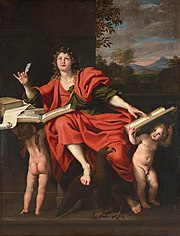Johannine epistles
| Part of a series of articles on |
| John in the Bible |
|---|
 |
| Johannine literature |
| Authorship |
| Related literature |
| See also |

The Johannine epistles, the Epistles of John, or the Letters of John are three of the catholic epistles of the New Testament, thought to have been written between 85 and 100 AD.[1] Most scholars agree that all three letters are written by the same author, although there is debate on who that author is.[2][3][4]
First[]
This epistle, unlike the other two, is written more as a sermon, one to help strengthen people's faith in Jesus, to help them understand why a being as great as the Son of God would have a mortal life and a mortal's agonizing death.[5]
Second[]
This epistle is written as a short letter from "the elder" to an unnamed "elect lady" whom he loves and her children.[6] Within the letter, John warns about opening her home to false teachers and to always practice truth, avoiding secrecy.

Third[]
The third epistle, also a short letter from "the elder", is addressed to a man named Gaius and mentioned as "a dear friend". It talks about a man named Diotrephes whom Gaius excommunicated from the church and had gone on to create an anti-missionary sentiment, trying to get the church to stop receiving missionaries. It is believed that the letter was delivered by a third person, Demetrius.
See also[]
- Authorship of the Johannine works
- Johannine Christianity
- Johannine Comma
- Johannine literature
References[]
- ^ Tenney, Merrill. "THE EPISTLES OF JOHN". www.abideinchrist.com. Retrieved 27 September 2012.
- ^ Kruger, Michael J. (30 April 2012). My library My History Books on Google Play Canon Revisited: Establishing the Origins and Authority of the New Testament Books. p. 272. ISBN 9781433530814.
- ^ Brown, Raymond E. (1988). The Gospel and Epistles of John: A Concise Commentary. p. 105. ISBN 9780814612835.
- ^ Marshall, I. Howard (14 July 1978). The Epistles of John. ISBN 9781467422321.
- ^ "THE EPISTLES OF JOHN". www.earlychristianwritings.com. Retrieved 27 September 2012.
- ^ Missler, Chuck. "A Timely Study: The Epistles of John". khouse.org. Retrieved 27 September 2012.
- Canonical epistles
- Johannine literature
- Christian studies book stubs